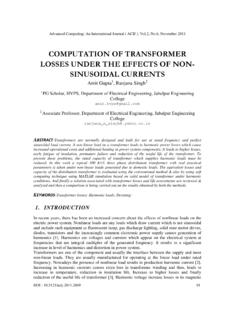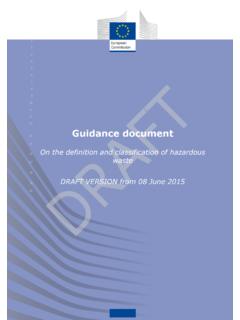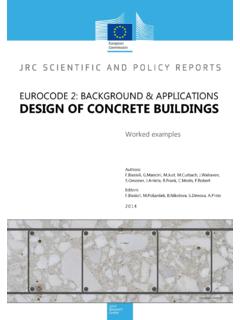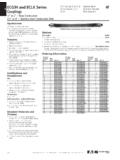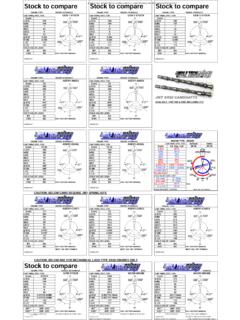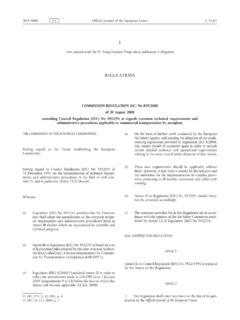Transcription of A study to examine the benefits of ... - European Commission
1 A study to examine the benefits of the End of Life Vehicles Directive and the costs and benefits of a revision of the 2015. targets for recycling, re-use and recovery under the ELV Directive Final Report to DG Environment In the framework of the contract to provide economic analysis in the context of environmental policies and of sustainable development A report submitted by GHK. 30, St Paul's Square, Birmingham, B3 1QZ. Tel: 0121 233 8900; Fax: 0121 212 0304. In association with Bio Intelligence Service Date: May 2006. J2232. Document Control Document Costs and benefits of the ELV Directive Final Report Job No. J2232. Prepared by JM, MR, SH (GHK), VM, EL, CH (BIO). Checked by SH (GHK). Date May 2006. J2232. CONTENTS. PART A: INTRODUCTION AND 1. 1 1. Background .. 1. Objectives of this study .. 4. Methodology and Process.
2 4. 2 CONCLUSIONS AND 8. Current benefits of the ELV Directive .. 8. Costs and benefits of Potential 2015 Targets .. 10. Recommendations .. 21. PART B: CURRENT benefits OF THE DIRECTIVE 23. 3 ECONOMIC benefits TO-DATE .. 23. Introduction .. 23. Resource Efficiency .. 23. Economic benefits to Public Authorities .. 25. Efficiency and Sustainability of the Treatment Sector .. 26. Reductions in Landfill 26. 4 ENVIRONMENTAL benefits 28. Introduction .. 28. Objective of this section .. 28. Scope of the analysis .. 28. Methodology 30. Topic 1 - Collection and treatment in authorised treatment facilities .. 34. Topic 2 - Depollution of ELV: 40. Topic 3 - Depollution of ELV: batteries .. 49. Topic 4 - Depollution of ELV: liquified gas tanks .. 56. Topic 5 - Depollution of ELV: air bags .. 58. Topic 6 - Removal of pieces: catalysts.
3 61. Topic 7 - Removal of pieces: 62. Topic 8 - Removal of pieces: glass .. 64. Topic 9 - Removal of pieces: large plastic components .. 65. Topic 10 - Removal of pieces: metal 68. Summary of environmental benefits to-date .. 69. Environmental impacts & benefits associated with 2006 71. PART C: FUTURE COSTS AND benefits OF THE DIRECTIVE .. 72. 5 OPTIONS FOR INCREASING RECYCLING AND RECOVERY 72. General Approach .. 72. iii GHK in association with BIO. End of Life Vehicle Composition .. 72. Current Practice .. 73. Review of the Technical Options and Related Costs for Treating ELVs .. 75. Future Recycling Markets .. 83. Treatment Options as the Basis of the Cost Assessment .. 85. Scenarios Describing the Nature of Treatment to Achieve Higher Recycling and Recovery Rates .. 86. 6 ESTIMATION OF THE COSTS OF INCREASED RATES OF RECYCLING AND.
4 RECOVERY .. 92. General Approach .. 92. Unit Costs of ELV Treatment 93. Indicative Costs of the Higher 94. Meeting Higher Targets with Technology Installed to Meet 2006 Targets .. 100. Sensitivity 102. Issues of 103. 7 ECONOMIC 106. ELV and Material 106. Gross Costs of the Directive .. 107. Incidence of 107. Effects on Operators .. 108. Effects on European 110. 8 ENVIRONMENTAL IMPACT .. 114. Environmental impacts & benefits associated with different treatments of plastics .. 114. Environmental impacts & benefits associated with different technical options for 2015. 167. Environmental impacts & benefits associated with 2006 182. iv GHK in association with BIO. A study to examine the Costs and benefits of the ELV Directive Final Report PART A: INTRODUCTION AND CONCLUSIONS. 1 INTRODUCTION. Background Disposal of cars and light commercial vehicles at the end of their operational lives (end of life vehicles ELVs) is estimated to generate over 10 million tonnes of material requiring treatment and disposal in 2005 within the EU.
5 This volume is projected to increase to 14 million tonnes by 2015 as the number and average weight of vehicles increases. The problems created by the generation of ELV waste arisings have been addressed by Directive 2000/53/EC (the ELV Directive'); which aims to reduce the amount of hazardous waste, increase the re-use, recycling and recovery of materials from ELVs and to improve the environmental performance of operators involved in the production and maintenance of vehicles and in the treatment of ELVs. Overview of the Directive The Directive contains 13 articles which outline the objectives, definitions and scope of the Directive (Articles 1-3), establish requirements for waste prevention (Article 4), set requirements for the collection of ELVs (Article 5), set environmental standards for treatment (Article 6), establish targets for reuse and recovery (Article 7), and specify coding standards and the provision of dismantling information (Article 8).
6 The remaining articles deal with reporting, implementation and administrative procedures. Annex I specifies in more detail the minimum technical standards relating to treatment in accordance with Articles 6(1) and 6(3), while Annex II lists certain materials and components exempt from the restrictions relating to hazardous substances in Article 4. (2)(a). General Approach to ELV Treatment The general technical process of dealing with ELVs is presented below (Figure ): Figure provides a more detailed overview of how ELVs arise and are treated in the EU. Vehicles reach the end of their life either because they become old and worn out and cease to be roadworthy ( natural end of life vehicles or NELVs) or because they are written off following involvement in an accident ( premature end of life vehicles or PELVs).
7 Vehicles may be sold for export either before reaching the end of their life as second hand vehicles, or at the point of deregistration as waste. Conditions for sales of second hand vehicles and ELVs (waste) are different since only the latter ones would be subject to waste legislation. 1. GHK in association with BIO. A study to examine the Costs and benefits of the ELV Directive Final Report Figure : Overview of the ELV Treatment Process ELV body shell Transport Dismantling Transport Shredding re-use recycling recycling energy recovery energy recovery landfill landfill Figure : Description of ELV Arisings and Treatment Vehicles in Use Exports Natural ELVs (old) Premature ELVs (accidents). ELV Arisings Reuse (batteries, fuel) Depollution Reprocessing (batteries, fluids) Remove battery, fluids, tyres, airbag Reuse of parts Dismantling Recycling of materials Remove parts/materials Shredding Recovery of metals Shred vehicle, reclaim metal Recovery of materials/fuels Treatment of ASR.
8 Energy recovery Thermal/mechanical Landfill of Residue 2. GHK in association with BIO. A study to examine the Costs and benefits of the ELV Directive Final Report Those vehicles that are not exported need to be treated at ATFs and undergo a process of depollution, involving the removal of fuel, oil and other liquids, as well as the battery, airbags and heavy metals. Some ELVs may be dismantled to remove valuable parts and materials, before they are sent to a shredder; others will be sent directly to the shredder. Shredding involves a capital intensive mechanical process and results in the recovery of metals from the vehicle, leaving auto-shredder residue (ASR), a combination of materials such as plastics, textiles and glass. ASR has traditionally been disposed of in landfill sites but is increasingly being treated to separate useable fractions and enhance rates of recycling.
9 Target Rates of Treatment of ELVs From 1 January 2006, 85% of ELV material by weight must go for recovery, re-use and recycling, with at least 80% of ELV material by average ELV weight going for recycling and re-use. The ELV Directive requires economic operators to meet the cost of achieving these targets through the requirement to ensure free take back of ELVs. In other words, any costs associated with meeting the targets above the value of an ELV at the time of de- registration can not be charged to the last user. To the extent that costs are incurred by public authorities or car producers above the value of ELVs, it may be that some form of additional charge to cover these costs in part or in full could be levied on the sale of new cars. The first example in the EU of this practice is in the Netherlands where, as part of a complete system for auto recovery (ARN), a waste disposal fee (45 euro) is levied on the first registration of the vehicle, which part finances a network of registered recycling and dismantling operators, and which meets the ELV targets for 2006.
10 Under the current provisions of the Directive, the proportions of ELV material required to go for recovery, recycling and re-use are due to change in 2015. Targets for 2015. onwards were set at 95% for re-use, recycling and recovery, and at least 85%. recycling and re-use. Table : Current Target Recycling and Recovery Rates for ELVs Target Dates Recycling & Re- Total Recovery, use Recycling & Re-Use 2006 80% 85%. 2015 85% 95%. Note: % by average weight of ELV. The higher recycling and recovery targets reduce the amount of waste that can be disposed of to landfill (the typical disposal route). The amount of waste that has to be treated depends on the actual weight of an ELV, which is estimated to be on average 1,025 kg in 2015, compared to an average weight in 2006 of 964 kg. 3. GHK in association with BIO.










